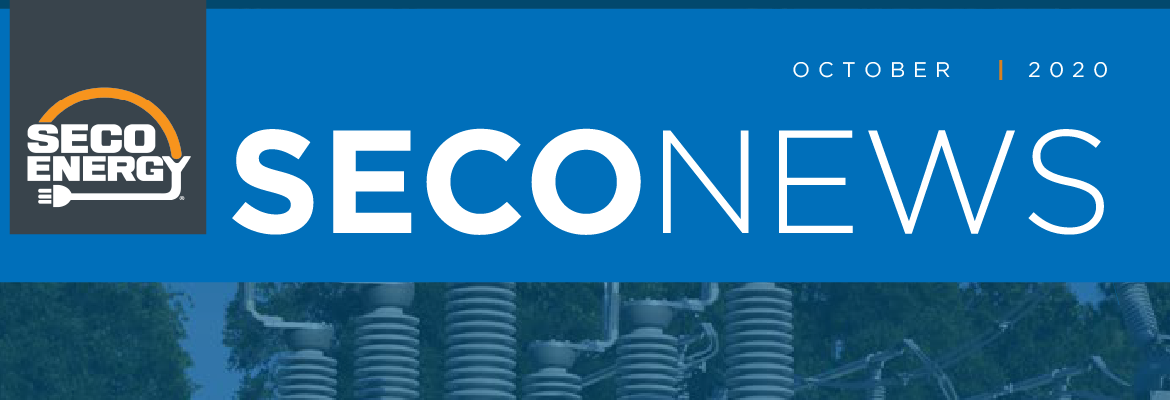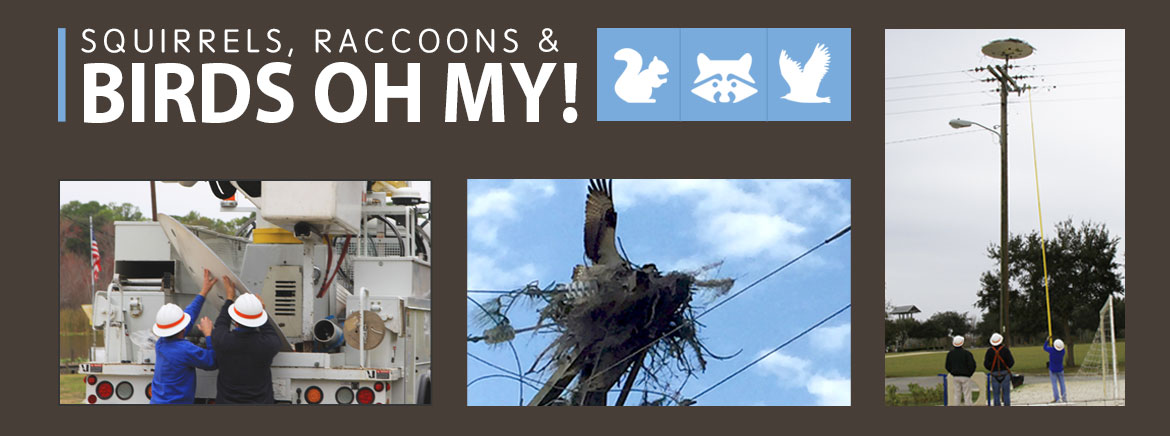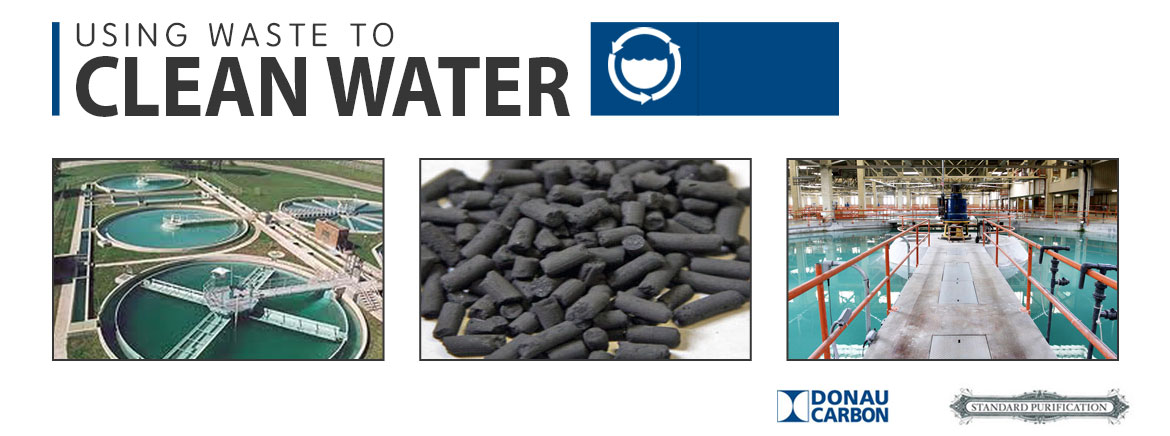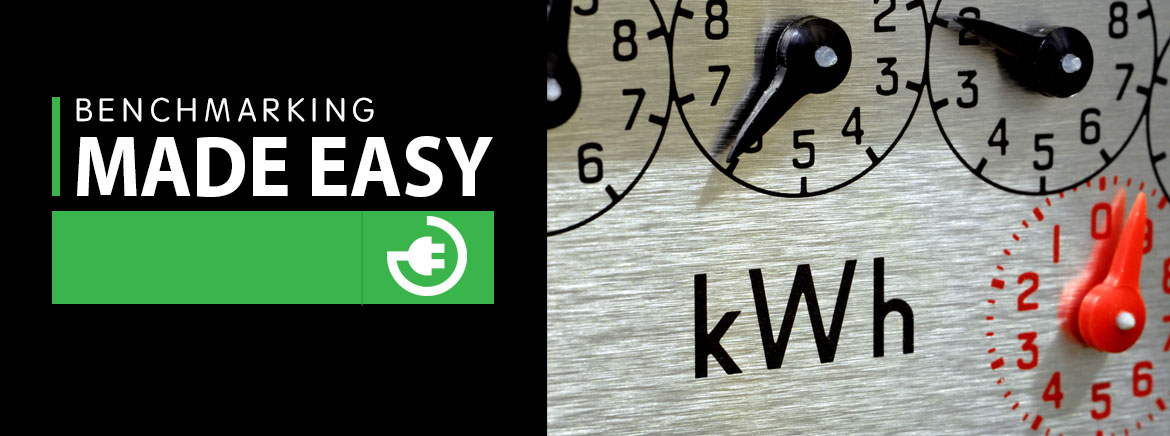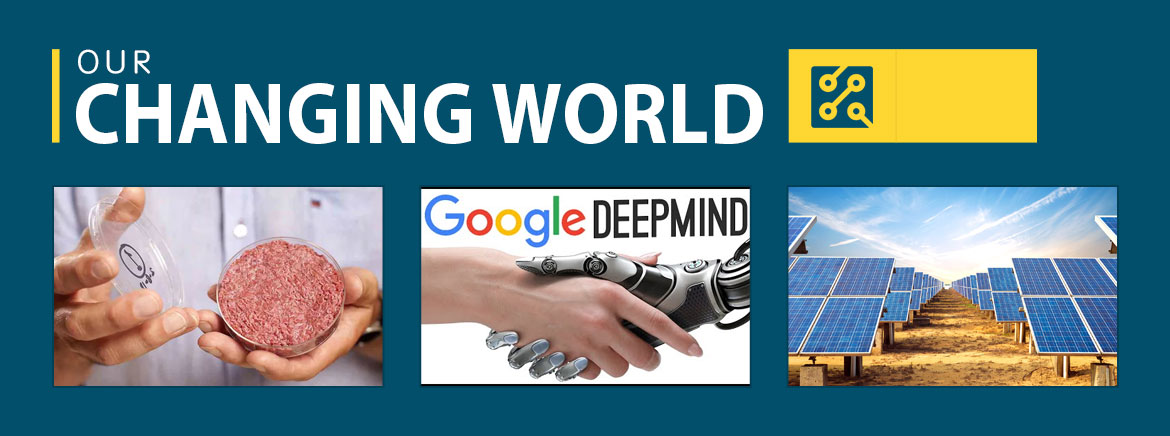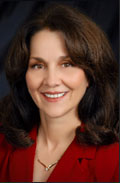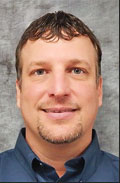SECO News, October 2020
Duncan’s Digest – Power Cost Adjustment Lowers Bills
SECO Energy’s mission is to construct, maintain and restore the electric system that serves over 210,000 homes and businesses in the counties we serve. As a not-for-profit electric cooperative that operates for our members, we are proud to provide safe, reliable, affordable electric service and offer world-class customer service.
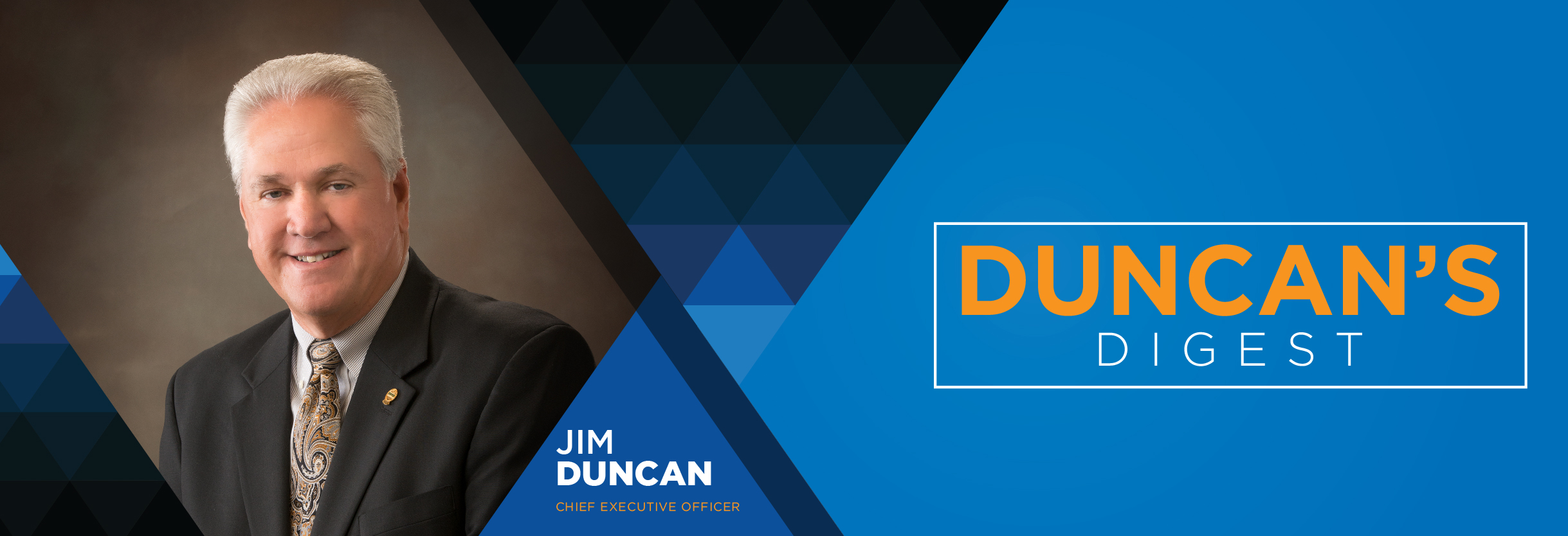
This month I have good news to share – SECO is once again lowering the cost of electric service. Beginning October 1, we are applying a higher member-favorable Power Cost Adjustment (PCA) credit to your bill. The PCA appears as a line item on your monthly bill titled “Hot Bucks.”
Since January 1, 2020, our rate for the first 1,000 kilowatt-hours (kWh) consumed has been $116.90. The reduction on October 1 will lower the amount by $4.50 per 1,000 kWh to $112.40 or approximately 4 percent.
The monthly bill’s PCA factor fluctuates based on the amount SECO pays for power purchased from our wholesale provider Seminole Electric Cooperative, Inc. We work closely with Seminole to ensure the lowest rates possible for members. When the wholesale cost of purchased power decreases, we pass the savings along to you.
Providing affordable electric service is a high priority for a not-for-profit electric cooperative like SECO. Going back to January 2014, the rate for 1,000 kWh was $127.75. We applied several member-favorable PCA adjustments since early 2014 to correspond with fuel cost decreases. There were times when fuel costs rose and we had to adjust the PCA to reflect the increase but for the most part, the PCA changes have consistently lowered members’ bills.
Between January 1, 2014, and October 1, 2020, the price for 1,000 kWh of electricity has decreased by $15.35 or over 12 percent.
SECO also wants to help you use our product efficiently and reduce your monthly energy consumption. Visit our Energy Efficiency page to complete the Home Energy Assessment for an online energy audit. Try the Energy Estimator to calculate the energy use and costs for your electronics, lighting, appliances and more.
The relationship between members and their electric cooperative is unique. It’s rare that a company wants you to use less of its product at a lower cost. That’s the cooperative difference. It is our privilege to serve as your electric provider.
Sincerely,
Jim Duncan
Chief Executive Officer

Phantom Load – It’s a Real Scare
Many everyday electronics consume electricity when plugged into an outlet even when turned “off.” TVs, DVD players, computer equipment, game or audio systems, cable boxes and phone or device chargers are the common culprits. This small amount of energy consumption called phantom load adds up to a real energy consumption trick.
Past studies estimate that phantom load is responsible for 10 to 20% of residential electricity consumption in the United States alone. Homes may have 20 to 40 sources of phantom load. The Department of Energy’s (DOE) website at energy.gov references a Lawrence Berkeley National Laboratory study that promotes electric power strips. Instead of unplugging multiple devices, a flip of the power strip switch turns off all devices plugged into the strip. Smart plugs are also available for devices such as cell phones that stop using electricity when the battery is charged.
What are some opportunities to scare away phantom load in your home? An old electric clock or TV in a spare bedroom? A battery charger for a forgotten tool? How about a computer and printer that is in use only once a week?
Ready to battle phantom load? Unplugging appliances and resetting clocks can be a chore. Our online Energy Estimator calculates the energy used and costs for common electronics and appliances in your home.
Don’t be scared – SECO’s Energy Estimator tool is available at no cost to you along with the Home Energy Assessment. Submit your Estimator with your email address and we’ll send you additional energy-efficiency treats – no tricks here. Both tools provide energy-efficiency advice tailored to the Energy home.

Advice from The Old Farmer’s Almanac
Autumn/winter skies offer planetary treat. The Old Farmer’s Almanac recommends looking for Mercury, Venus, Mars, Jupiter and Saturn in the autumn and winter skies. Mercury’s position closest to the sun makes it visible during twilight hours in November and December, and Venus is visible as a morning star. Mars is visible all night on October 13 and will continue to be brightly visible through 2020. Jupiter will be visible during the first half of the night in autumn but will pass near Saturn in winter. Look for Jupiter and Saturn to pass closely during the solstice on December 21. Saturn is visible before midnight through autumn. Remember, Jupiter is much brighter than Saturn.
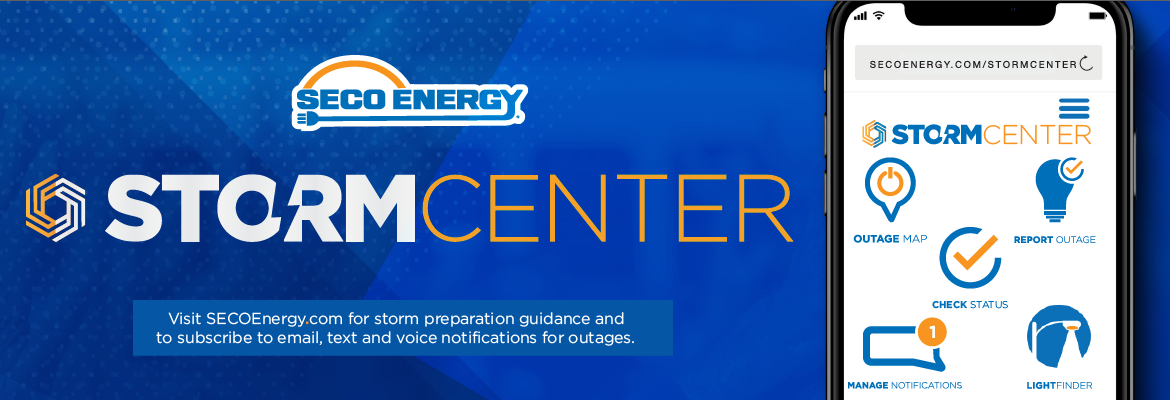
StormCenter
Visit StormCenter to view our interactive outage map, subscribe to email, text and voice notifications for outages, check the status of an existing outage and more. You’ll find storm preparation tips and guidance in our Hurricane Handbook online.

Keep It Clear – We Work Here
Safety is our top core value at SECO Energy. Our Keep It Clear – We Work Here campaign promotes and ensures a safe working environment for our employees and contractors.
Members sometimes place obstructions such as plants, fences, shrubbery and other lawn items that block personnel’s safe access to SECO equipment. Members are responsible for keeping SECO-owned equipment and the area surrounding equipment clear. Obstructions are a safety hazard to employees and contractors and create longer restoration times.
The whyfors of the need for clearance on all sides are safety driven. Multiple employees work on this type of equipment while it’s energized – often in the dark and in adverse weather conditions. Our focus is on the safety of our field employees and contractors who maneuver around equipment with eight-foot hot sticks and bulky testing equipment. Battling shrubs, potted plants, fencing, bird baths, sharp objects and other obstructions can delay restoring power and prevent us from doing so safely. One slip or a difference of a sliver of an inch could result in an employee or contractor getting seriously injured or killed.
We are conducting equipment inspections across the service area. View the diagrams and photos on the opposite page as a clearance guide for transformers, secondary enclosures and meters. In addition to this SECO News article, you will be receiving email, text or voice notifications warning to clear obstructions around electric equipment. If you have an obstruction and an Energy Services Specialist must visit the property after multiple attempts to garner cooperation, disconnection of service may occur. This step is a last resort but one that is supported by our Terms & Conditions of Service.
Visit our Keep It Clear – We Work Here page if you have questions.
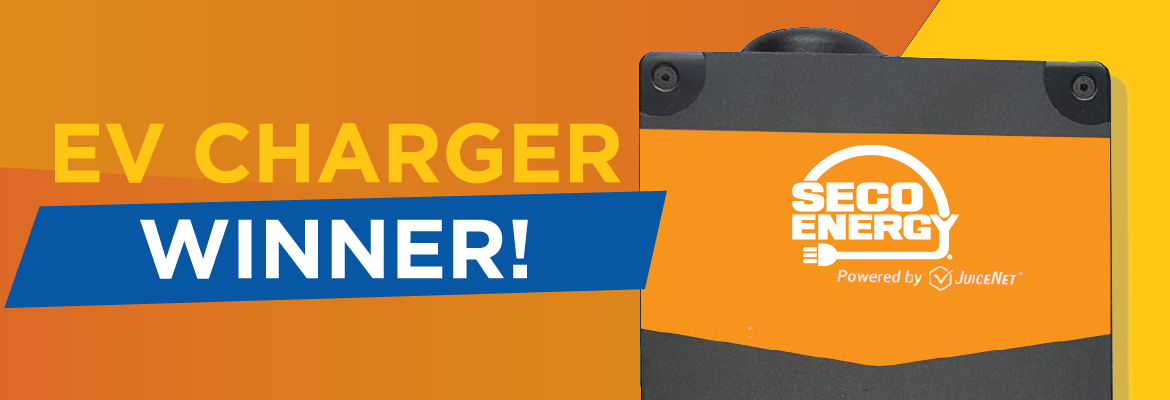
EV Charger Winners
We have two EV Level Two charger winners to announce this month. Frank Maglio from The Villages is the August winner. We dropped by Mr. and Mrs. Maglio’s home to deliver the EV charger. The couple already has an electric hybrid Ford Fusion and was so excited to be a winner! Simon Johnson from Clermont is the September winner of a SECO Energy branded JuiceBox Pro 40 EV Level 2 charger. We’re giving one charger away each month while supplies last. To enter, text “EV” to (352) 320-4500 for a link to enter. Or click on the EV Charger Giveaway homepage banner.
Learn more about the benefits of electric vehicle ownership on our EV website pages. You’ll find an EV savings calculator, information about CO2 reduction, an EV and PHEV model finder and a nationwide charger-finder map. Visit our Electric Vehicles page for more information.
Watch SECO News for next month’s charger winner.

Winner’s Circle
Congratulations to Jerome Szelak of Leesburg, who is the winner of a Nest Learning Thermostat. In a July SECO News promotion, we entered all members enrolled in surge protection by August 15 in this prize drawing. Mr. Szelak’s name was drawn at random from thousands of Surge MitiGator enrollees.

Scam Alert – Solar Scams
Scam artists have new tricks up their sleeves. We hear more and more from members who are concerned about solar scams. Remember these wise words: If it sounds too good to be true, it’s most likely a trick.
The latest solar scams are installers posing as SECO Energy contractors. Members report seeing groups of people walk up and down the streets in neighborhoods insisting that all residents must be on a “solar plan” or SECO will receive a fine. They threaten that SECO will raise rates astronomically and attempt to harass or intimidate you into investing in a solar array that may cost you big bucks.
Slam the door on these scammers! They are not authorized SECO Energy contractors. We do not force members to enroll in “solar plans” or buy expensive equipment.
You may have seen posts on social media or yard signs advertising “free solar” or “no electric bill solar.” These claims are also too good to be true. Solar panels and their installation are expensive and never “free.” This claim often relates to leasing solar panels. Here’s how it typically works: The homeowner enters into a lease agreement or a power purchase agreement (PPA) with a solar installer. The system belongs to the solar company, not the homeowner. The company then sells the energy produced back to you at a fixed price per kilowatt hour (kWh). If kWh rates go down at your local utility, you are stuck paying the solar company the fixed rate. The homeowner is still connected to the utility grid and now pays a bill to the solar contractor and their local utility. You’ll also likely end up with a lien on your home until the system is paid off – whether you lease or finance the system.
A competent, reputable solar installer will meet with you to determine your goals when installing a solar system on your home. They will review your recent consumption history to help you choose the system size that meets your needs. They will not make promises that are too good to be true. Homeowners with solar panel systems interconnected to SECO’s electric system still receive a monthly bill. Members who have solar systems without battery or generator backup will continue to use utility-supplied power at night or when the sun isn’t shining and are billed a monthly customer charge. Homeowners will not have power during a utility outage unless they invest in a robust battery or generator backup system.
SECO Energy is a partner for members who choose to reduce their utility-supplied power by installing a solar system. We will not try and dissuade you from choosing to reduce your utility-supplied power by investing in solar. Our Energy Services team specializes in solar system knowledge and will be happy to help you navigate the false advertising and claims made by less-than-reputable solar contractors and installers.
We have a host of resources online, visit the Is Solar Right for You? page. You’ll find an FAQ section, view a sample solar bill, a net metering explanation and independent resources to research the facts and dispel solar myths and false claims. If you decide solar is right for you, SECO provides an easy to navigate online Interconnection Platform where you and your contractor will collaboratively plan your system installation.
Read the full October 2020 SECO News online.



